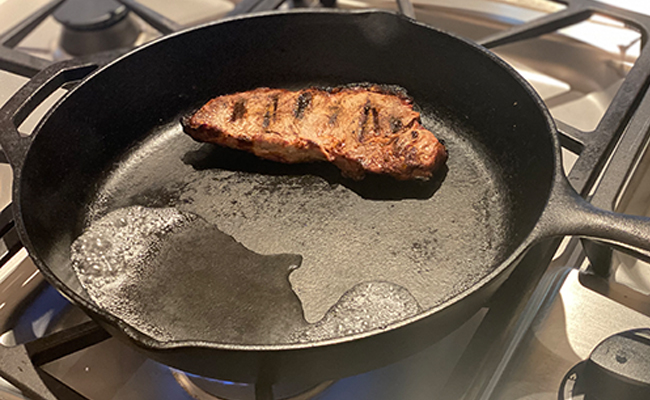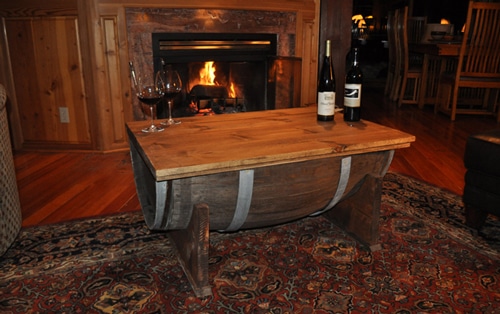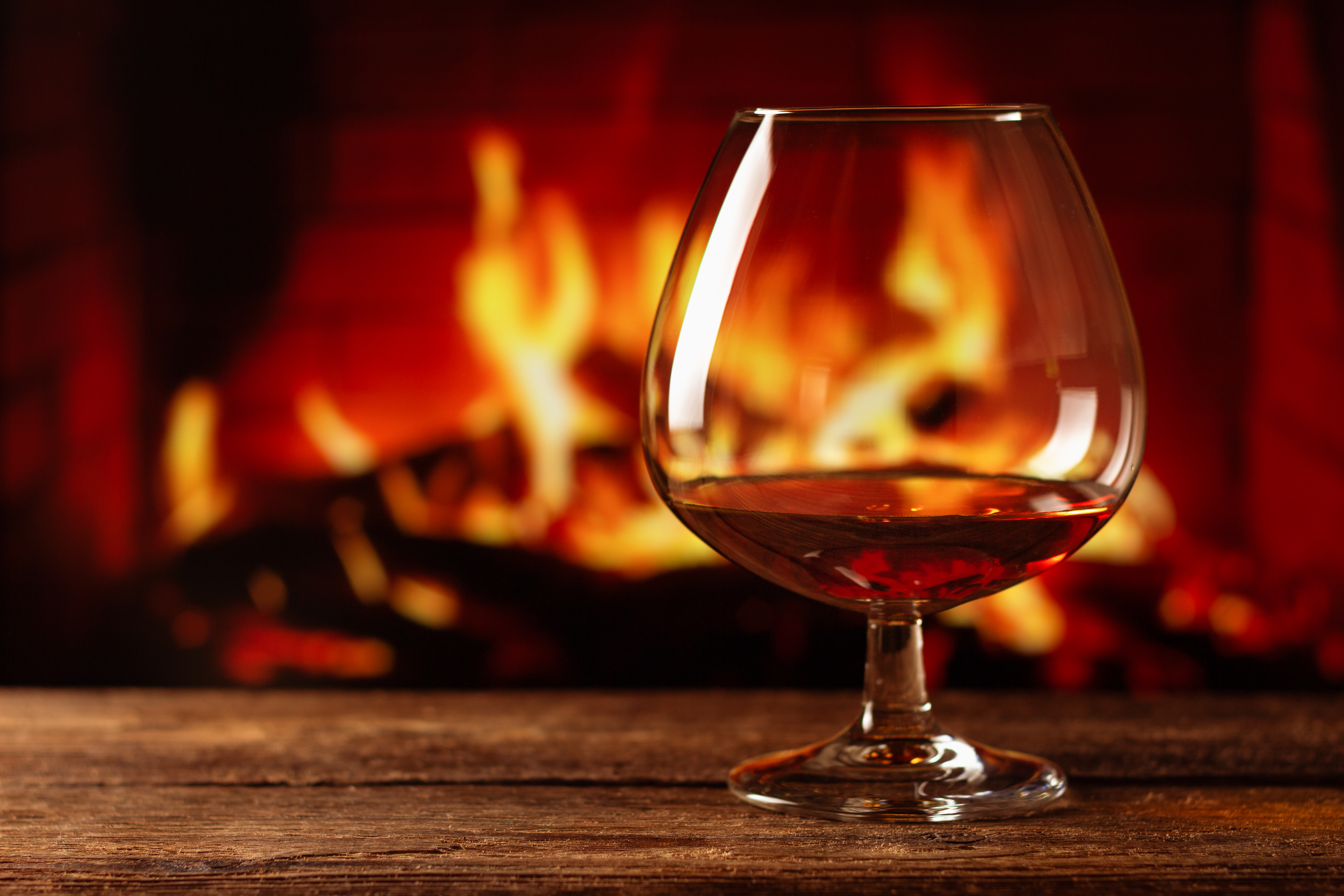
While whiskey was first billed as a medicinal substance — aquavitae or “water of vitality” — it soon gained popularity and became one of the most popular drinks in the world. Whiskey as we know it was probably first distilled in the 1400s, and probably in Scotland, according to the best hard evidence we have. Especially in England and Ireland, it became the drink of choice, and through taxation, came to contribute 30%-50% of the nation’s revenue.
With the colonization of the states, the popular beverage crossed the Atlantic, and Mr. George Washington himself counted whiskey as his favorite vice. He even opened a distillery at Mount Vernon which ended up being one of the largest in the young nation. They continue to make whiskey today.
In spite of its sometimes tumultuous history (see the Whiskey Rebellion), whiskey is a drink that men have enjoyed for centuries. Men like Mark Twain, Winston Churchill (often accompanied with a fine cigar), and Clark Gable imbibed regularly. When one thinks of masculine images, you often conjure up a picture of a man in a tweed coat with a glass of whiskey in his hand by the fire. If you’ve ever wanted to be that man and explore this manly tradition, you’re in luck. While we’ve given you a primer on Scotch whisky, today we’re going to broaden that and talk about whiskey as a whole — especially how to enjoy it!
I had the opportunity to talk with Jess Graber, founder of TINCUP American whiskey, to get his tips on how to drink this classic spirit. If you’re ever in Woody Creek, Colorado, look him up; he’s the kind of guy you’d love to share a drink with.
How to Find Your Favorite Whiskey
To fully enjoy drinking whiskey, you first need to know some of the basics about the spirit itself — the various styles, the alcohol levels, how to pick yourself a bottle, etc. Whiskey is defined as an alcoholic beverage that is distilled from fermented grains and aged in wooden casks (most commonly oak). The video below provides a much better description of how whiskey is made than I ever could in writing. While it’s particular to Scotch whisky, the overall process is the same.
Unfortunately, going to a liquor store or a bar and surveying all the whiskies available can be intimidating. There are plenty of terms (single malt, rye whiskey, blended whiskey, etc.) that don’t mean much unless you’ve done a little bit of homework.
The easiest way to distinguish whiskies is by nationality, and then broken down into subcategories from there that give a little further detail. While these are certainly generic terms, and you’ll find a few other varieties out there, these will cover most of what you encounter:
- American whiskey — tends to be sweeter than other whiskies. American whiskies must be distilled in America and aged in barrels in order to be labeled as whiskey (usually for two years, but not always). Breaks down into the further subcategories:
- Bourbon — distilled from at least 51% corn.
- Rye — distilled from at least 51% rye.
- Tennessee — bourbon that is distilled in Tennessee and filtered through charcoal.
- Scotch whisky — tends to have smoky and earthy flavors. Distilled in Scotland, from mostly barley, and aged at least 3 years. Breaks down into further subcategories:
- Blended Scotch — literally just a blend of one or more Scotch whiskies.
- Single malt Scotch — distilled at a single distillery from malted barley.
- Irish whiskey — tends to be light-bodied, but more robust than Canadian whiskey. Distilled in Ireland, aged at least 3 years.
- Canadian whiskey — tends to be light-bodied and fruity. Distilled in Canada and aged at least 3 years. They are typically blends.
You’ll also find alcohol content on whiskey labels. It may either be labeled directly as a percentage or as a “proof.” To find the percentage from a proof, simply divide the number in half. So a 100-proof whiskey is 50% alcohol by volume. You’ll find a range of 40% to 60% ABV in whiskies, with the lower end being more common.
The best way to go about choosing a whiskey, in my own experience, is to pick a style, and try a few different whiskies from that style. Try a cheap bottle ($10-$15), a middle-of-the-road bottle ($20-$35), and a spendier bottle ($35-$100), and compare them. (You don’t have to do this all at once! Take a couple months with each bottle you buy and get to know the flavors.) You probably won’t be able to tell too much of a difference in actual flavor at first, other than spendier versions being smoother and having a little less burn (this is because the longer it’s aged, the more the wood lessens the harshness). When you try a bourbon with 45% alcohol, and then one with 50% alcohol, you’ll definitely notice the difference in that 5%.
Over time, your taste buds will mature, and you’ll be able to at least partially distinguish different flavors and different styles of whiskey. A good starting style is Canadian or Irish, as they’re a little lighter and fruitier. From there, you can move on to American whiskies, which have a little more flavor and variety. And finally, you should probably try Scotch last, because it’s the most distinct flavor and the “harshest” for someone who’s not had much whiskey.
How to Drink Whiskey
Choosing Your Drinking Vessel

The Old Fashioned — or “rocks” — glass.
Now, when it comes to drinking vessels, you can get as snooty as you want for really any alcoholic beverage. Before I get too much into this section, let me say right off that bat that it’s perfectly fine to have whiskey out of a plastic or styrofoam cup if that’s what you have. As I said, to each their own, and do what you will to enjoy what you’re drinking.
Having said that, there are some vessels that are better than others to really maximize the flavor. And let’s be honest, some glasses just look better than others. Presentation can make a difference. Is it mental? Maybe. But I think one’s chosen drinking vessel adds to the experience and the feeling of ritual.
If possible, always serve whiskey in a glass; other materials can taint the flavor. I serve my whiskey in a “rocks” glass – otherwise known as an Old Fashioned or lowball glass. It’s really just a short tumbler that will hold about 6-10oz of liquid.
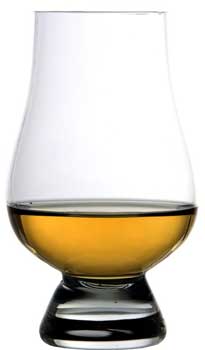
To really step it up a notch, you could get yourself some specialty whiskey glasses. These are tulip-shaped (above), and will concentrate the vapors and flavors and allow you to really “nose” the whiskey (more on that a little later). It may seem snooty, but it really does make a difference. I don’t have any of these…yet.
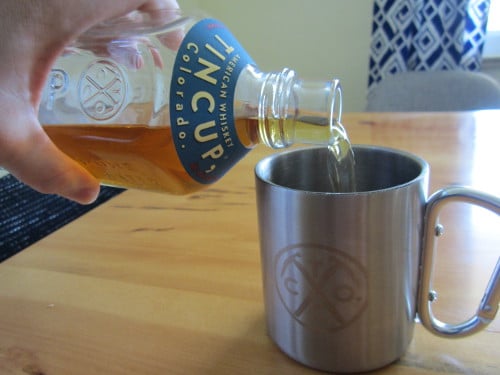
A tin cup from TINCUP. How fitting.
Feel like kickin’ it old school? Have your whiskey in a tin cup. Jess told me that in the 1800s miners would drink their whiskey out of a tin cup because glass was far more fragile, and shipping it over the mountains via carriage (railways didn’t have access to every part of the country) would make glassware liable to break. The tin was cheaper, and that’s what men in the mountains used back in the day. Admittedly, it changes the flavor some and naturally makes it a little “tinny,” but the experience of drinking out of a tin cup like the great men of over a century ago makes it worth it every once in a while. The durability of a tin cup also makes it ideal for when you’re consuming your whiskey in the great outdoors.
Check out our article on the best whiskey glasses.
Neat? Water? Ice?
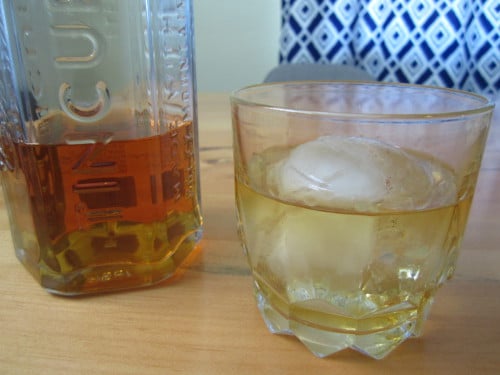
If using ice, use a large cube or sphere vs smaller ice cubes.
This was one of my first questions for Jess, and is perhaps the most hotly debated among whiskey drinkers.
This is what he told me, “The first time you drink any whiskey, it should be tasted neat. That’s what the guy who made it wants it to taste like. We made TINCUP at 84 proof because it’s nice to drink it neat. When it gets really high [in terms of alcohol percentage], it numbs most people’s taste buds. You wanna taste what the guy made.”
When you add water or ice, what you’re doing is lowering the ABV of the beverage in your hand. For one serving (1.5oz), a teaspoon of water will lower a 40% ABV beverage to 30%.
Especially for high-proof whiskies, many experts will add just a little bit of tap water. This is to dilute the beverage a little bit, but also to soften the punch of the alcohol and let the whiskey flavor really come through. If you try this route, add just a tiny bit of water, see how it tastes, and add a splash more if desired. If you end up with too much water, your only remedy is to add more whiskey.
While many whiskey experts will decry the use of ice, it’s personally my favorite way to drink whiskey. Unless it’s a very smooth, high-end whiskey, you’ll likely need just a little something to take the punch off. The experts say that making the whiskey cold numbs the flavors a little bit, but I like my whiskey chilled, and I’ve tried all options enough to know what I like.
Instead of adding normal-sized ice cubes, I prefer using big cubes or spheres. With less surface area, they melt slower. So your whiskey gets chilled, but less watered down than if using regular ice cubes. There are also whiskey stones, but in my experience, they don’t actually work all that well at chilling the whiskey to the temperature I like. We’ll actually be doing an article this summer on various ice and cooling options for beverages, so I won’t get into it too much here.
Sipping and Savoring the Spirit
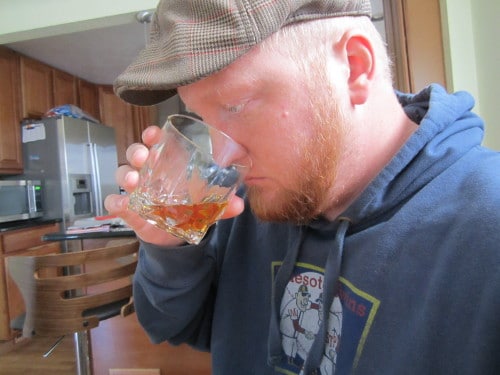
Nosing the whiskey.
As with any alcoholic beverage, there are certain flavors to look for while drinking, and certain methods to the drinking that will help release and identify those flavors. For instance, with wine, you want to smell it, let it settle for a few minutes, then let the liquid linger in your mouth so you can get all the flavors.
When it comes to drinking or eating just about anything, you want to let your nose inform your mouth. Believe it or not, the sensation of flavor is a combination of smell and taste. For complex flavors, like those found in many alcoholic beverages, the sense of smell is even more important.
So before you take any sip of whiskey, you want to really get your nose in the glass and take a hearty whiff. As Mr. Graber says, “The first thing is your nose. Your nose will educate your palette. We like sweet things, so you’re going to focus on that at first.”
That first sniff will largely be just alcoholic, and might clear your nostrils a little bit. So give it a second and third sniff and you’ll get some of the true whiskey flavors.
Next, take just a small sip, and sort of roll the liquid around in your mouth. Instead of just swallowing right away, try to pick out different flavors. Since whiskey is always aged in wooden barrels, you’ll almost always get the classic flavors of vanilla, toffee, or caramel. From there, enjoy your drink over the course of 30-60 minutes, with good company of course, and you’ll be a happy whiskey drinker.
What About Cocktails?
Ah, the controversy of cocktails. As I’m sure you’re seeing a trend, many whiskey drinkers will be snooty and say that adding anything other than whiskey to your whiskey is heresy. You’ll even find this sentiment on certain whiskey labels – “Best enjoyed neat or with a dash of water.”
It all comes down to your own opinion, and what you like. That’s it. Mr. Graber – founder of two whiskey companies – notes that while your first try of any whiskey should be neat, after you’ve gotten to know the beverage, you can play around a little and find out what you like. While I tend to enjoy whiskey as its own beverage, every once in a while it’s certainly fun to add additional flavors to the mix.
My favorite cocktail, without a doubt, is the Manhattan. My own personal recipe that I use at home:
- 2oz whiskey (either rye or bourbon – TINCUP is a great option here since it’s a high rye bourbon)
- 1oz sweet vermouth
- 3-4 dashes of bitters
- Maraschino cherries
- Fill a pint glass up with ice cubes.
- Put whiskey, vermouth, and bitters into that glass. Stir for 30 seconds or so.
- In an Old Fashioned glass, place a cherry, and also pour in a small amount of the juice from the cherry jar.
- Strain mixed contents from pint glass into the Old Fashioned glass, and you’re all set.
- Every once in a while, I’ll make a flavored Manhattan (tis my wife’s favorite). For this, I’ll buy some peach or apple whiskey, and use 1oz of that with 1oz of regular whiskey. All the other ingredients remain the same.
You’ll certainly hear a lot of things from a lot of people (“experts” or otherwise) about how to properly drink whiskey, which whiskies to drink, and how much you need to spend. Don’t listen to any of those people. Ultimately, drink what you’d like and how you’d like to drink it. These are guidelines, not rules. So grab a glass, pour yourself some whiskey, kick back in your leather man chair, and do some taste testing.
What’s your favorite whiskey? What’s your favorite whiskey cocktail? Tell me below in the comments!



